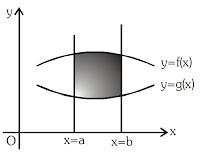AREA UNDER THE CURVE
6. CURVE TRACING :
The following outline procedure is to be applied in Sketching the graph of a function \(y=f(x)\) which in turn will be extremely useful to quickly and correctly evaluate the area under the curves.
(a) Symmetry : The symmetry of the curve is judged as follows:
(i) If all the powers of \(y\) in the equation are even then the curve is symmetrical about the axis of \(x\).
(ii) If all the powers of \(x\) are even, the curve is symmetrical about the axis of \(y\).
(iii) If powers of \(x \) & \(y\) both are even, the curve is symmetrical about the axis of \(x\) as well as \(y\).
(iv) If the equation of the curve remains unchanged on interchanging \(x\) and \(y\), then the curve is symmetrical about \(y=x\)
(v) If on replacing 'x' by '-x' and 'y' by '- \(y\) ', the equation of the curve is unaltered then there is symmetry in opposite quadrants, i.e. symmetric about the origin.
(b) Find \(\dfrac{dy }{ dx}\) & equate it to zero to find the points on the curve where you have horizontal tangents.
(c) Find the points where the curve crosses the \(x\) -axis & also the \(y\) -axis.
(d) Examine if possible the intervals when \(f ( x )\) is increasing or decreasing. Examine what happens to 'y' when \(x \rightarrow \infty\) or \(-\infty\).
7. USEFUL RESULTS :
(a) Whole area of the ellipse, \(\dfrac{x ^{2} }{ a ^{2}}+\dfrac{ y ^{2} }{ b ^{2}}=1\) is \(\pi ab\).
(b) Area enclosed between the parabolas \(y^{2}=4 a x \) & \(x^{2}=4by\) is \(16 ab / 3\)
(c) Area included between the parabola \(y^{2}=4\)ax & the line \(y=m x\) is \(8 a^{2} / 3 m^{3}\)
(d) Area enclosed by the parabola and its double ordinate \(P , Q\) is two-third of area of rectangle PQRS, where R,S lie on tangent at the vertex.



Comments
Post a Comment